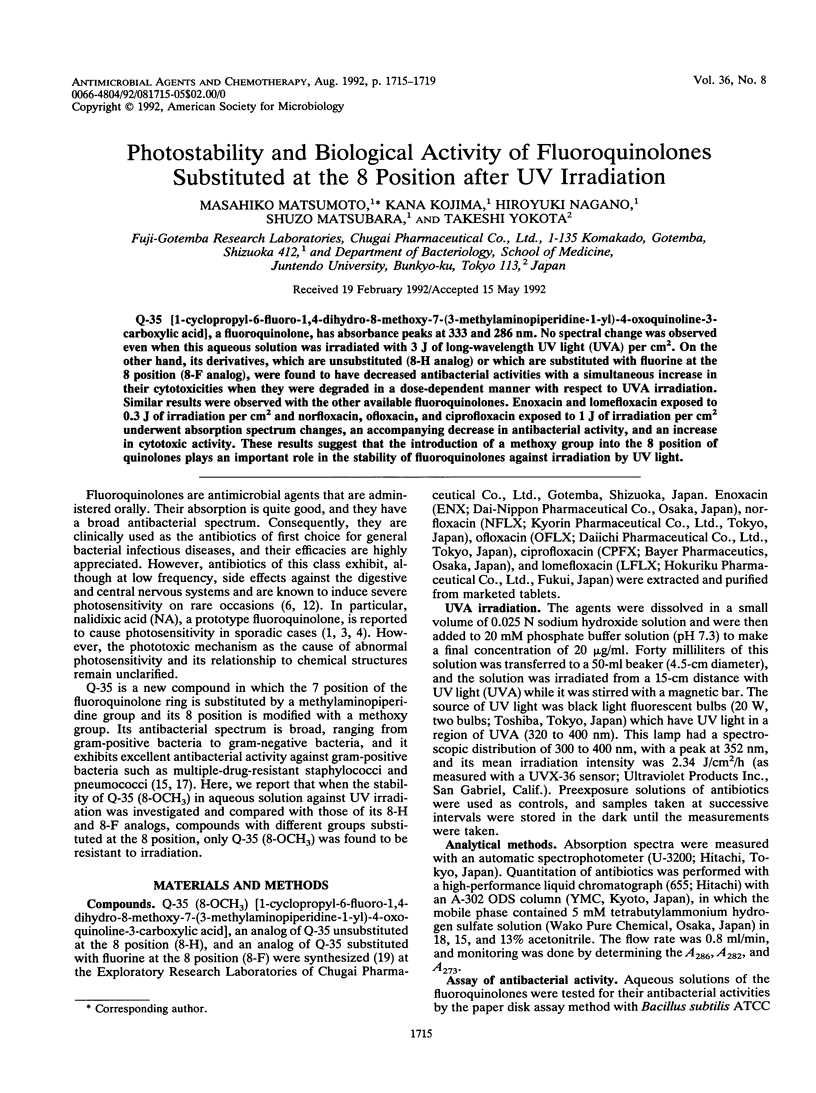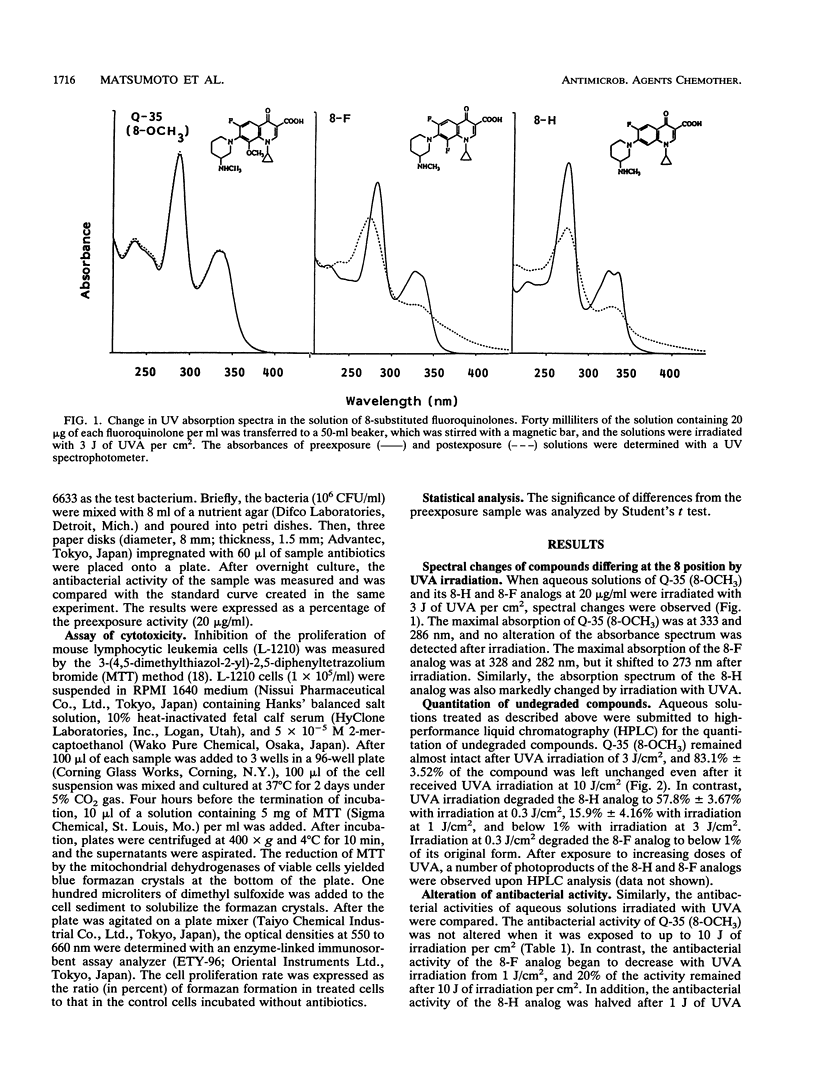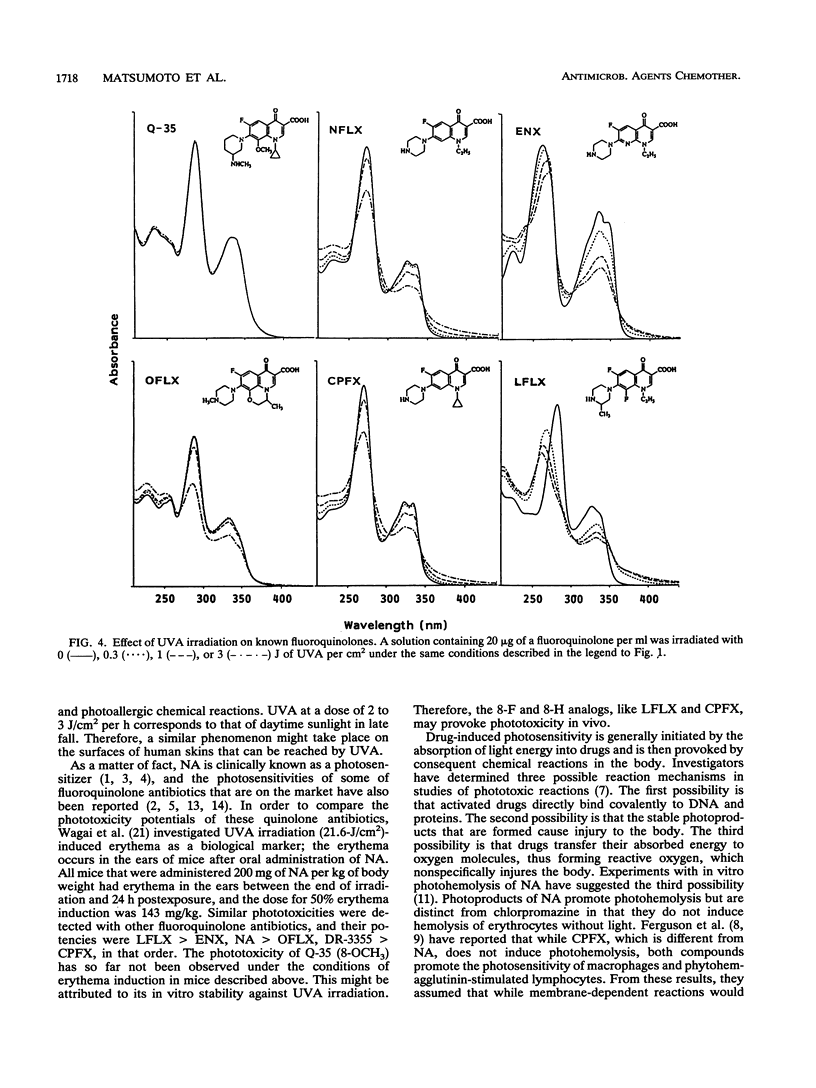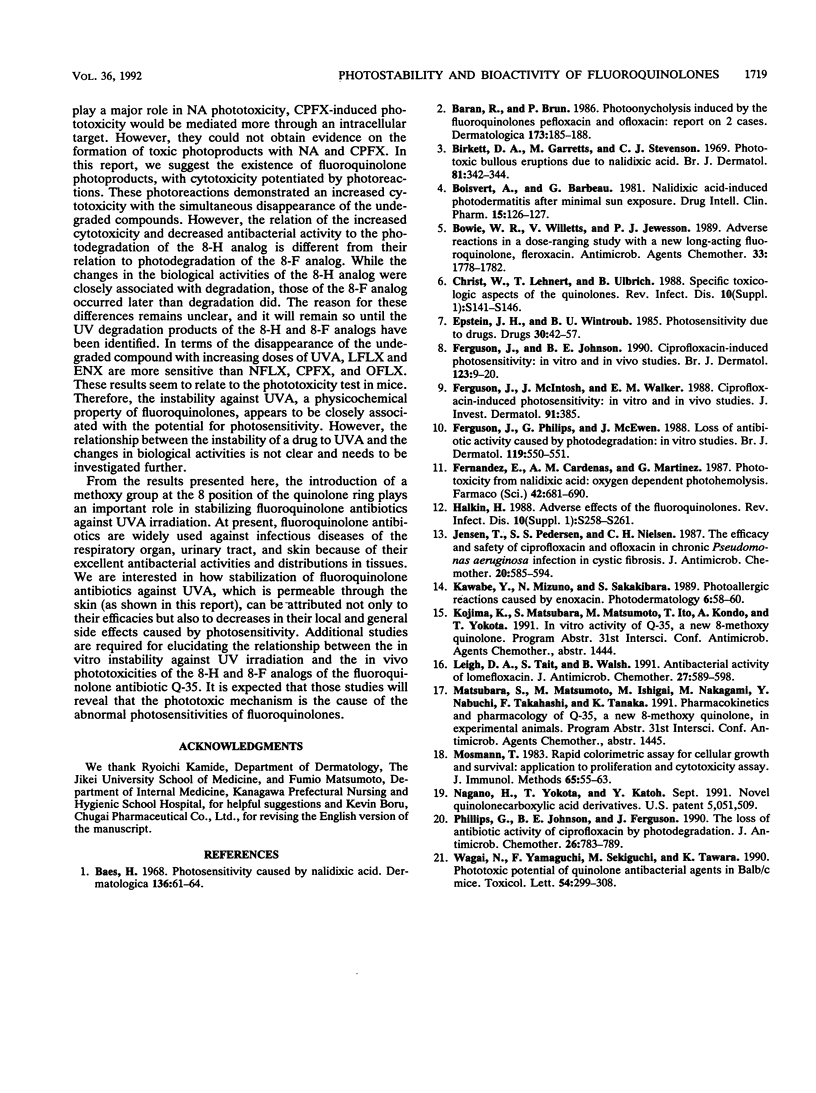Abstract
Q-35 [1-cyclopropyl-6-fluoro-1,4-dihydro-8-methoxy-7-(3-methylaminopiperid ine-1-yl)-4-oxoquinoline-3-carboxylic acid], a fluoroquinolone, has absorbance peaks at 333 and 286 nm. No spectral change was observed even when this aqueous solution was irradiated with 3 J of long-wavelength UV light (UVA) per cm2. On the other hand, its derivatives, which are unsubstituted (8-H analog) or which are substituted with fluorine at the 8 position (8-F analog), were found to have decreased antibacterial activities with a simultaneous increase in their cytotoxicities when they were degraded in a dose-dependent manner with respect to UVA irradiation. Similar results were observed with the other available fluoroquinolones. Enoxacin and lomefloxacin exposed to 0.3 J of irradiation per cm2 and norfloxacin, ofloxacin, and ciprofloxacin exposed to 1 J of irradiation per cm2 underwent absorption spectrum changes, an accompanying decrease in antibacterial activity, and an increase in cytotoxic activity. These results suggest that the introduction of a methoxy group into the 8 position of quinolones plays an important role in the stability of fluoroquinolones against irradiation by UV light.
Full text
PDF




Selected References
These references are in PubMed. This may not be the complete list of references from this article.
- Baran R., Brun P. Photoonycholysis induced by the fluoroquinolones pefloxacine and ofloxacine. Report on 2 cases. Dermatologica. 1986;173(4):185–188. doi: 10.1159/000249247. [DOI] [PubMed] [Google Scholar]
- Birkett D. A., Garretts M., Stevenson C. J. Phototoxic bullous eruptions due to nalidixic acid. Br J Dermatol. 1969 May;81(5):342–344. doi: 10.1111/j.1365-2133.1969.tb13994.x. [DOI] [PubMed] [Google Scholar]
- Boisvert A., Barbeau G. Nalidixic acid-induced photodermatitis after minimal sun exposure. Drug Intell Clin Pharm. 1981 Feb;15(2):126–127. doi: 10.1177/106002808101500208. [DOI] [PubMed] [Google Scholar]
- Bowie W. R., Willetts V., Jewesson P. J. Adverse reactions in a dose-ranging study with a new long-acting fluoroquinolone, fleroxacin. Antimicrob Agents Chemother. 1989 Oct;33(10):1778–1782. doi: 10.1128/aac.33.10.1778. [DOI] [PMC free article] [PubMed] [Google Scholar]
- Christ W., Lehnert T., Ulbrich B. Specific toxicologic aspects of the quinolones. Rev Infect Dis. 1988 Jan-Feb;10 (Suppl 1):S141–S146. doi: 10.1093/clinids/10.supplement_1.s141. [DOI] [PubMed] [Google Scholar]
- Epstein J. H., Wintroub B. U. Photosensitivity due to drugs. Drugs. 1985 Jul;30(1):42–57. doi: 10.2165/00003495-198530010-00005. [DOI] [PubMed] [Google Scholar]
- Ferguson J., Johnson B. E. Ciprofloxacin-induced photosensitivity: in vitro and in vivo studies. Br J Dermatol. 1990 Jul;123(1):9–20. doi: 10.1111/j.1365-2133.1990.tb01819.x. [DOI] [PubMed] [Google Scholar]
- Ferguson J., Phillips G., McEwan J., Moreland T., Johnson B. E. Loss of antibiotic activity caused by photodegradation: in vivo studies. Br J Dermatol. 1988 Oct;119(4):550–551. doi: 10.1111/j.1365-2133.1988.tb03264.x. [DOI] [PubMed] [Google Scholar]
- Fernández E., Cárdenas A. M., Martínez G. Phototoxicity from nalidixic acid: oxygen dependent photohemolysis. Farmaco Sci. 1987 Sep;42(9):681–690. [PubMed] [Google Scholar]
- Halkin H. Adverse effects of the fluoroquinolones. Rev Infect Dis. 1988 Jan-Feb;10 (Suppl 1):S258–S261. doi: 10.1093/clinids/10.supplement_1.s258. [DOI] [PubMed] [Google Scholar]
- Jensen T., Pedersen S. S., Nielsen C. H., Høiby N., Koch C. The efficacy and safety of ciprofloxacin and ofloxacin in chronic Pseudomonas aeruginosa infection in cystic fibrosis. J Antimicrob Chemother. 1987 Oct;20(4):585–594. doi: 10.1093/jac/20.4.585. [DOI] [PubMed] [Google Scholar]
- Leigh D. A., Tait S., Walsh B. Antibacterial activity of lomefloxacin. J Antimicrob Chemother. 1991 May;27(5):589–598. doi: 10.1093/jac/27.5.589. [DOI] [PubMed] [Google Scholar]
- Mosmann T. Rapid colorimetric assay for cellular growth and survival: application to proliferation and cytotoxicity assays. J Immunol Methods. 1983 Dec 16;65(1-2):55–63. doi: 10.1016/0022-1759(83)90303-4. [DOI] [PubMed] [Google Scholar]
- Phillips G., Johnson B. E., Ferguson J. The loss of antibiotic activity of ciprofloxacin by photodegradation. J Antimicrob Chemother. 1990 Dec;26(6):783–789. doi: 10.1093/jac/26.6.783. [DOI] [PubMed] [Google Scholar]
- Wagai N., Yamaguchi F., Sekiguchi M., Tawara K. Phototoxic potential of quinolone antibacterial agents in Balb/c mice. Toxicol Lett. 1990 Dec;54(2-3):299–308. doi: 10.1016/0378-4274(90)90197-t. [DOI] [PubMed] [Google Scholar]


